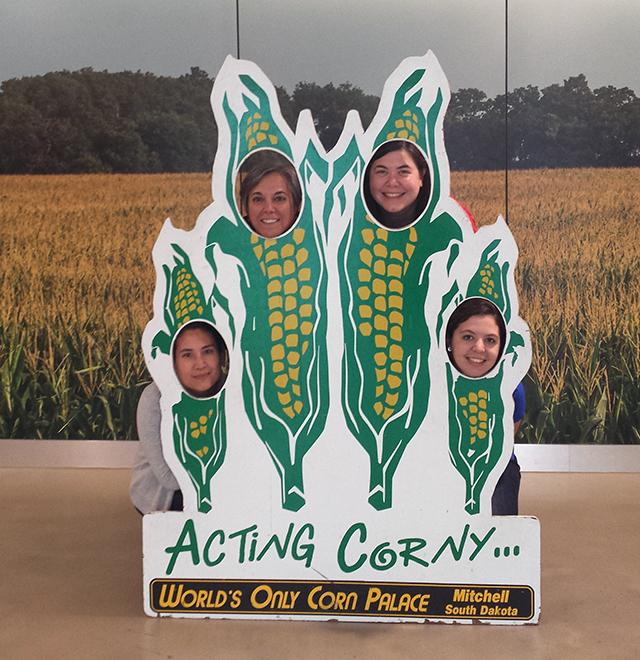by Sara Ring
Quick Summary
Minitex staff traveled to Rapid City South Dakota in late September to attend and present at the South Dakota Library Association Annual Conference. Along the way, we stopped at Dakota Wesleyan University in Mitchell and the School of Mines & Technology in Rapid City, South Dakota. Below is a brief summary of both site visits, along with a few takeaways from the annual conference. See you next year SDLA!

Minitex staff traveled to Rapid City South Dakota in late September to attend and present at the South Dakota Library Association Annual Conference. Along the way, we stopped at Dakota Wesleyan University in Mitchell and the School of Mines & Technology in Rapid City, South Dakota. Below is a brief summary of both site visits, along with a few takeaways from the annual conference. See you next year SDLA!
Dakota Wesleyan University Site Visit
Director Kevin Kenkel gave us a tour of the library named for George McGovern and his wife Eleanor. George McGovern was a Dakota Wesleyan graduate, State Representative, and Senator. Here’s what we saw on our tour:
- A collection of framed photographs of the opening of the library which was attended by President Clinton, among other distinguished guests
- The campus bookstore in the library!
- A large Civil War special collection
- A Western history special collection. Currently on display were books by author Badger Clark (cowboy poetry anyone?)
- Engraved roses on the book ends of the stacks (a nod to the Margaret Teufel Children's Collection, an endowed collection)
- A children’s playroom for student-parents who bring their children to the library
- Lots of lounge space for students and group study areas
- A huge three-room archives space
- The George McGovern Legacy Museum, adjacent to the library entrance
- A free book display next to a cozy fireplace and coffee shop
Photographs from this site visit can be found on the Minitex Facebook page.
School of Mines & Technology Site Visit
The next day we visited the South Dakota School of Mines & Technology in Rapid City, South Dakota. Cindy Davies (Associate Librarian) and her dog Trooper showed us around Deveraux Library, which has recently undergone a major shift in the collection. The Library collection and staff offices were moved from the basement to the first and subsequent floors of building (4 floors total). Other interesting things we saw at the library include:
- Welcome lollipops when you enter the library
- A huge 3d topographical map of the Black Hills mining regions, originally created for the Worlds Fair in 1904
- Individual and group study areas
- Chunks of cornerstone from the first two buildings on campus (1885), which no longer exist.
- Shovels from several groundbreaking ceremonies (archives)
- Grubby the Miner school mascot costume (archives)
- A wonderful mural painted by a student worker
- A display of an original 23 foot wide engineering drawing of the Crouch Railroad
We had to cut our site visit short to make it in time for the opening keynote at SDLA that same afternoon! Photographs from this site visit can be found on the Minitex Facebook page.
South Dakota Library Association Annual Conference
Opening keynote speaker Jamie LaRue, director of Douglas County Library System in Colorado, presented “The Big Picture: 5 Transformative Trends.” The five trends he outlined for libraries included:
- Emergent literacy
- Community reference
- Library as publisher
- Library as place
- Advocacy: Telling the Library Story
The trend that resonated most with me was his discussion of community reference. He asked his staff how they can show their value to the community beyond the physical and virtual walls of the library. LaRue was invited to a meeting of a downtown development council, a group who sought to improve the downtown shopping district, and, soon after, an embedded librarian experiment was born. A team of librarians started attending their meetings, taking minutes, providing research, and putting reports and PowerPoint presentations together based on the results of their research. After the experiment, the council was asked to describe the value of the library. They mentioned that the library brought their group expert research, communication, and credibility because they were working with a trusted partner, the library. The first experiment expanded into a program of embedded librarianship (in schools, in city councils, economic development councils, etc.) at Douglas County.
My colleague Jolie Graybill remarked that the "Advocacy: telling the library story" trend resonated the most with her. LaRue said libraries are very good at providing statistics from gate counts to usage related to services. However, many need to work on actually telling their heartfelt stories of meaning and/or value, how the library changed and impacted the community and individual lives of the community.
